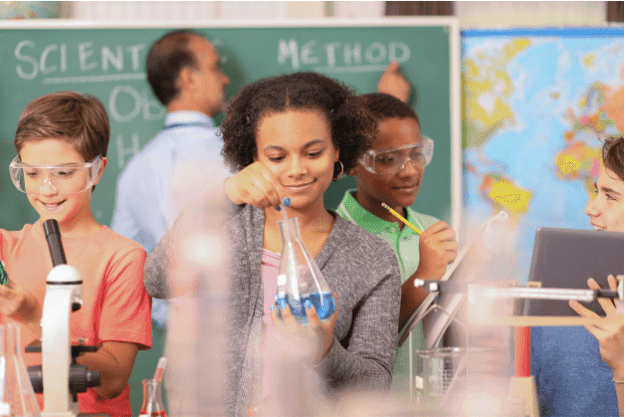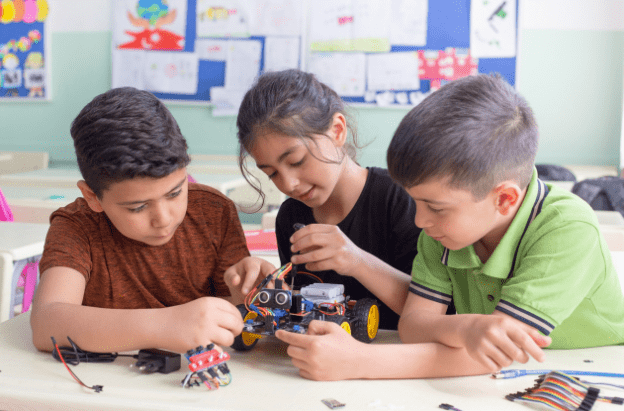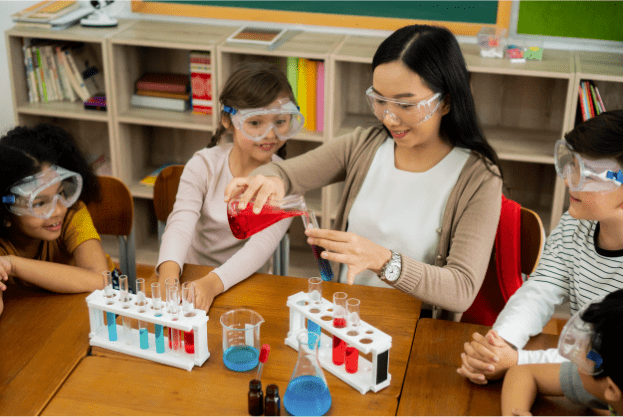10 Enrichment Ideas to Make Your Middle School Classroom More Exciting
Written by Eryn Gordon

Middle school is a time of curiosity, exploration, and budding passions. It’s a crucial period when students develop their interests and build a foundation for future academic pursuits.
To elevate their learning experience and make education truly come alive, we present the 10 best enrichment ideas for middle school students. These activities are designed to engage, inspire, and nurture the diverse talents and interests that make each student unique.
What Is Enrichment and Why Is It Important in Middle School?
The dictionary defines enrichment as the action of improving or enhancing the quality or value of something. When we think of enrichment of the classroom, it’s any kind of activity that engages students beyond standard lecture-style lessons.
Enrichment activities are a great way to build new skills, reinforce creativity, and develop critical thinking. Because middle school students are at a formative stage in their academic development, this is an ideal time to encourage thinking beyond boundaries.
1. STEAM Workshops
Introduce the exciting world of Science, Technology, Engineering, Arts, and Mathematics (STEAM) through hands-on workshops. From building simple machines to creating digital art, STEAM activities blend creativity with critical thinking.
STEAM classroom workshops in K-12 classrooms provide a dynamic and holistic approach to education and foster critical thinking, creativity, and problem-solving skills. To maximize the effectiveness of these workshops, educators should start by designing hands-on activities that integrate principles from each STEAM discipline.
One example of a STEAM workshop in a classroom could be a “Solar-Powered Design Challenge.” In this workshop, students would work collaboratively to design and build a solar-powered device that serves a practical purpose. The project would integrate various STEAM elements.
Throughout the workshop, students would engage in critical thinking, problem-solving, and collaboration, reflecting the interdisciplinary nature of STEAM education. The culmination of the project would involve presentations by students, who would explain their design choices, showcase their working prototypes, and discuss the real-world applications of their solar-powered devices.
2. Book Clubs and Literary Circles
Book clubs can foster a love for reading and critical analysis. Encourage students to explore diverse genres, discuss themes, and express their opinions.
To initiate this activity, educators can begin by selecting age-appropriate literature that aligns with the curriculum or themes relevant to students' interests. Next, divide students into small groups. and allow them to choose their books or offer a curated selection.
Assigning roles, such as discussion leader, summarizer, and connector, within each group empowers students to take ownership of their learning. Regular meetings provide a platform for collaborative discussions as participants share insights, analyze characters and plot developments, and explore literary devices.
Educators can guide these discussions, ensuring they stay focused and encouraging students to support their opinions with evidence from the text. Additionally, incorporating creative projects or presentations related to the books enhances comprehension and expression.
Book clubs and literary circles not only deepen students’ understanding of literature but also promote communication skills, critical analysis, and a lifelong appreciation for reading. Guest authors or visits to local libraries can add an extra layer of excitement.
3. Robotics and Coding Classes
Equip students with essential 21st-century skills by introducing them to robotics and coding. Programming small robots or creating their digital games can turn learning into a thrilling adventure.
To implement this effectively, educators should begin with age-appropriate coding activities that introduce foundational concepts and gradually progress to more complex programming languages as students advance. Robotics allows students to apply their coding skills in a tangible and interactive way. Hands-on projects, such as building and programming robots, can be designed to align with various subjects, illustrating the interdisciplinary nature of STEM (Science, Technology, Engineering, and Mathematics) education.

Collaborative projects promote teamwork, communication, and the sharing of diverse perspectives. Teacher assessments can focus on both the coding proficiency and the functionality of the robots and encourage students to troubleshoot and iterate their designs.
4. Environmental Science Projects
Cultivate a sense of environmental stewardship through science projects. Whether it’s creating a school garden, studying local ecosystems, or participating in environmental clean-up initiatives, students can actively contribute to a sustainable future.
Utilizing outdoor spaces, when possible, enhances the experiential learning aspect. Incorporating interactive experiments, field trips, and guest speakers provide students with real-world connections to environmental science concepts. Workshops can cover diverse subjects, from ecosystems and biodiversity to climate change and sustainability.
Teachers should foster a spirit of inquiry by encouraging students to ask questions, make observations, and analyze data. Projects that involve designing solutions to local environmental challenges empower students to become environmental stewards. Moreover, linking environmental science to other disciplines, such as mathematics and language arts, enriches the learning experience.
5. Debate and Public Speaking Clubs
Implementing a new K-12 classroom project that focuses on debate can be a dynamic way to foster critical thinking, communication skills, and the art of persuasion. An open forum can also provide a platform for students to express and explore the full scope of their opinions. However, teachers should ensure that students differentiate between expressing a debate topic and engaging in an argument.
To initiate this, educators can select age-appropriate topics that are relevant and engaging for the students. Students can be divided into teams, assigned positions, and provided with research materials to prepare their reasoning. The workshop can kick off with a discussion on debate etiquette and the importance of respecting differing opinions.
Classroom debates can cover a range of subjects, from historical events to current social issues. During the workshop, students take turns presenting their reasoning, rebutting opposing points, and fielding questions from both classmates and the teacher. The emphasis should be on evidence-based reasoning and effective communication. This not only sharpens their debate skills but also cultivates a deeper understanding of diverse perspectives.
Post-debate reflections and discussions further encourage students to analyze and articulate their thoughts.
6. Artistic Expression
Unleash creativity through various artistic outlets. Providing avenues for artistic expression – from painting and sculpture to drama and music – allows students to discover and develop their unique talents.
One example could be a multicultural art project during which students create a collaborative mural representing the diversity of their classroom community. Educators can introduce the workshop by discussing the importance of cultural awareness and the role of art in expressing identity.
Students can then share personal stories, traditions, or symbols that represent their backgrounds. Armed with this inspiration, they can use a variety of artistic mediums such as painting, drawing, or collage to contribute to the mural.
This not only promotes artistic skills but also fosters empathy and understanding among students. The culminating event could involve a gallery walk, which allows students to present their contributions. This fosters an appreciation for the rich tapestry of cultures within the classroom.
7. Math Puzzles and Games
Make math fun by incorporating puzzles and games into the curriculum. Math competitions, puzzle-solving challenges, and interactive games not only reinforce mathematical concepts but also turn learning into a delightful experience.
For example, educators can introduce a “Math Challenge Day” that has students rotate through stations featuring various puzzles and games. One station might involve a Sudoku competition, which promotes logical reasoning and pattern recognition. Another station could feature a board game that requires strategic thinking and basic arithmetic skills.
Teachers can tailor the difficulty levels to different grades, ensuring that each activity aligns with the curriculum. By framing these challenges as enjoyable games, teachers can get students to approach mathematical concepts with enthusiasm and reduce students’ fear of the monotony often associated with the subject.
8. Cultural Immersion Experiences
Broaden students’ perspectives by organizing cultural immersion experiences. Virtual or physical visits to museums and historical sites or presentations by guest speakers from different cultures can enhance students’ understanding of the world.
Educators can organize a “Cultural Exchange Day” and have each student or group represent a different country or cultural region. Students would engage in in-depth research to understand the traditions, history, and customs of their assigned culture.
The workshop can include presentations, traditional food tastings, and interactive activities such as dance or art demonstrations. This immersive experience deepens students’ cultural awareness and promotes respect for diversity.
9. Service Learning Projects
Instill a sense of empathy and social responsibility through service learning projects. Whether it’s volunteering at local charities or organizing community outreach events, students are taught valuable life skills during the projects while making a positive impact.
Implementing service learning workshops in a K-12 classroom involves integrating community service projects with academic learning, fostering empathy, and instilling a sense of social responsibility. For instance, educators might organize a “Community Garden Project” and have students learn about biology, ecology, and sustainability while actively participating in the creation and maintenance of a school garden.
This project allows students to witness the real-world application of their academic knowledge and directly contribute to the well-being of their community. The workshop can include lessons on environmental science, teamwork, and nutrition, and align with various subjects in the curriculum.
10. STEM Career Exploration

Introduce students to potential STEM careers through engaging workshops and guest speakers from various fields. Field trips to science and technology companies or virtual Q&A sessions with professionals can inspire future scientists, engineers, and innovators.
Start by organizing a “STEM Career Fair” and have professionals from various STEM backgrounds visit the classroom to share their experiences and insights. Students could engage in hands-on activities, interactive demonstrations, and Q&A sessions with guest speakers. This workshop not only introduces students to STEM concepts in a real-world context but also allows them to envision potential career paths.
In addition, educators can incorporate activities such as resume building, mock interviews, and discussions about the educational pathways required for different STEM professions.
Enrich Your Middle School Classroom
Middle school enrichment is about more than just expanding academic horizons; it’s about igniting a passion for learning that lasts a lifetime. By incorporating these 10 enrichment ideas, educators and parents can create an environment where students not only excel academically but also discover their unique strengths and interests.
As we fuel their brilliance, we empower them to become lifelong learners with the confidence to explore, innovate, and make a positive impact on the world. The journey to knowledge is an adventure, and these enrichment activities are the compass guiding students on their path to greatness.